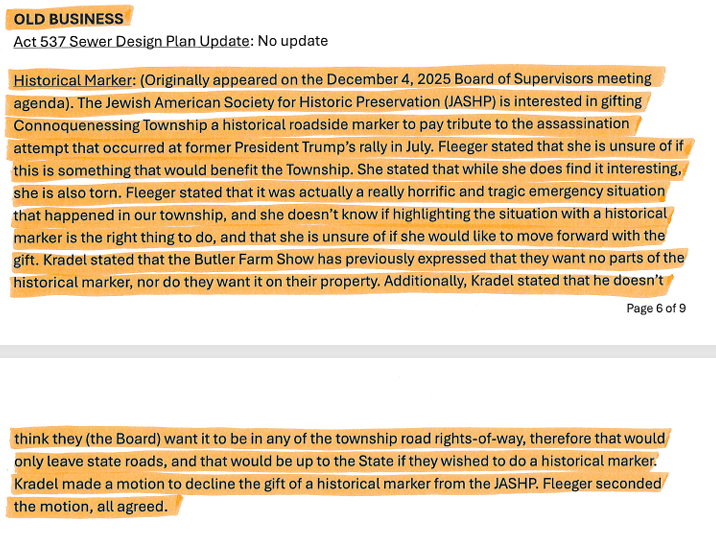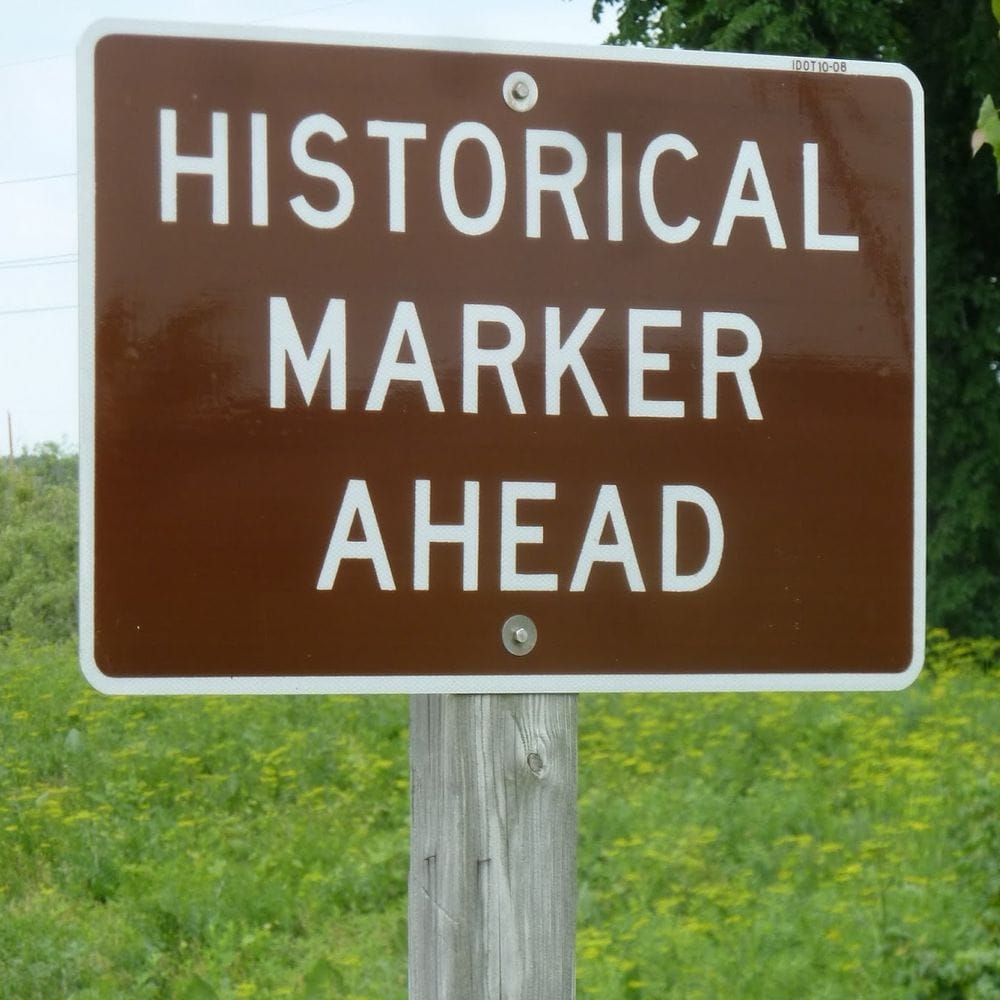Why the Trump attempted assassination historical marker is a no-go
It comes down to two words: too soon. Here's why historical markers don't happen until well after an event.

The locals decided despite the offer of a free historical marker, they'd rather not post a reminder of a day they'd rather forget.
On Jan. 5, 2025, the three-member Township of Connoquenessing Board of Supervisors formally turned down an offer from the Jewish American Society for Historic Preservation for a free historical marker to be placed at or near the site of the July 13, 2024, assassination attempt on then-candidate, now-President Donald Trump.
I contacted the township office multiple times to hear more about why they said no, but they didn't get back to me. I understand, because getting a message along the lines of "I run a historical marker BlueSky account and I'd like to talk to you about your plaque debate" sounds like I'm a crank. (I'm not a crank.) (Note: they got back to me after the township Feb. 6 Board of Supervisors meeting with the approved minutes that detail why they said no. More below.)
However, I'm pretty sure (especially after a conversation with Hunter Muro, the Butler Eagle reporter who covered the marker issue) why they said no, and after a little background I'll tell you the reasons I gave to Jerry Klinger, a retired senior vice president at Merrill Lynch now spending his retirement in Florida, and contributing historical markers. Basically it's this: too soon.
But first, a little background
Klinger made the offer in late November 2024, hoping to have a marker up by the first anniversary of the event, July 13, 2025. Most of his markers are centered on Jewish people and history, as well as Zionism and Israel, and placed in 44 states and nine countries. Klinger said he felt strongly about a marker at the Trump site because, in his words, the assassination attempt represented not just trying to kill a candidate, but also to kill a voice, and with it trying to kill democracy. Klinger said he is a Trump supporter, but that his politics weren't driving the marker. You might not believe that, but I'm taking him at his word.
Klinger said the Connoquenessing officials he talked to seemed interested in the marker, and he was surprised when they said no.
“Honestly, it was a tragic event that took place in our township,” the Butler Eagle quoted Supervisor Angela Fleeger as saying during the meeting when the township turned him down. “I just don’t know that highlighting that tragedy was the right thing for our township at this time, so we politely declined the gift.” (Klinger wasn't at the meetings where the marker was discussed, which isn't unusual.)
A person who has worked to put up markers in 44 states and nine countries is familiar with negotiating the vagaries of local politics to get a marker approved, and is also used to being turned down. Klinger said after the denial he got notes from random folks surmising that maybe the township said no because of doubts Trump was actually shot (then-FBI director Chris Wray said it wasn't clear whether Trump's famously bloodied ear was the result of a bullet or shrapnel from his Teleprompter), or because of anti-Semitism (in his Times of Israel blog, Klinger speculates his failure to success ratio has gone from 1:1 to 3:1 in the last year because something "fundamental has changed in America since the massacre of Israelis on October 7. The word 'Jew' has become toxic.")
After Klinger shared this with me, I gave him my "too soon" theory. I'll go into a little more detail, and add some local flavor from Muro, the Butler Eagle reporter, who also did not take me for a crank and agreed to talk to me.
Markers need time
Usually an event needs a minimum of 50 to 60 years before it reaches historical marker status. It takes time for an agreeable narrative to develop, including the context in which that narrative lives. Note: that "agreeable" narrative reflects the time in which the marker is raised, and can change to the point a new marker is needed.
Tragedies need distance
Klinger said he thought Connoquenessing Township might be amenable to a Trump assassination attempt marker because the area already had one related to an attempt another president's life – George Washington. But that marker was put up more than 200 years after that attempt, and Washington also wasn't president at the time of the attempt.
Generally, if a marker goes up at all following a tragedy, it's very discreet, for two reasons.
One is that community and family members grieving the tragedy are alive, so a marker might feel trivial or unwelcome. Muro said the area residents who went to the rally, and even those who didn't, are still shaken by the shooting. That a president they generally like was put at risk certainly contributes to that feeling, Muro said.
But he said their feelings aren't driven completely by their favorite president. They are still trying to absorb that a shooting of this scale happened at all, and are concerned about the family of Corey Comperatore, who died during the attempt while trying to protect them. (The proposed language in Klinger's proposed marker would've mentioned him heroically.) Muro said the highest-trafficked Butler Eagle stories related to the assassination attempt are updates on the Comperatore family. (On its official government website, Connoquenessing Township describes itself as "a tightly knit agricultural and residential community of 4,100 residents.")
The second reason is that a business or community might not want people seeing a marker about a tragedy, and getting nervous picturing it happening, or avoid the area as a result – or gathering as some sort of shrine. That feeling is present in Connoquenessing Township, Muro said. And I get it – when I walked into the Safeway where there's a small and very subtle marker to a 2011 Arizona mass shooting that killed six and wounded then-Rep. Gabby Giffords at a community event, it was a little unnerving to go in and buy doughnuts and Vitamin Water imagining what it must have been like that day.
By the way, there's a marker at the Washington Hilton for the 1981 assassination attempt on Ronald Reagan, but that went up decades after he was shot – and after Reagan's 2004 death. As much as I can find, you don't otherwise see markers for presidential assassination attempts.
The official reason for saying no
But enough conjecture. On Feb. 7, after I originally posted this piece, Megan Hineman, the Connoquenessing Township secretary, sent me a copy of the Jan. 5 Board of Supervisors meeting minutes, approved at the Feb. 6 meeting, that stand as the official statement as to why the township said no. Megan said she waited for those official minutes before responding, which was wise, and given that I have a flexible platform that I can update any time, is no issue to me.
It encompasses what I said above, emotional issues that also feed into a few basic but often insurmountable questions when it comes to placing a marker – where do you put it, and who's in charge of putting it there? Here is what was in the minutes:
Historical marker: (Originally appeared in the December 4, 2025 Board of Supervisors meeting agenda). The Jewish American Society for Historic Preservation (JASHP) is interested in gifting Connoquenessing Township a historical roadside marker to pay tribute to the assassination attempt that occurred at former President Trump's rally in July. [Supervisor Angela] Fleeger stated that she is unsure of if this is something that would benefit the Township. She stated that while she does find it interesting, she is also torn. Fleeger stated that it was actually a really horrific and tragic emergency situation that happening in our township, and she doesn't know if highlighting the situation with a historical marker is the right thing to do, and that she is unsure of if she would like to move forward with the gift. [Supervisor Vice Chair Ricky] Kradel stated that the Butler Farm Show [site of the rally where the assassination attempt occurred] has previously expressed that they want no parts of the historical marker, nor do they want it on their property. Additionally, Kradel stated that he doesn't think they (the Board) want it to be in any of the township road rights-of-way, therefore that would only leave state roads, and that would be up to the State if they wished to do a historical marker. Kradel made a motion to decline the gift of a historical marker from the JASHP. Fleeger seconded the motion, all agreed.

Here's are the rules and application for a Pennsylvania state historical marker, if anyone wants to keep pursuing this.
